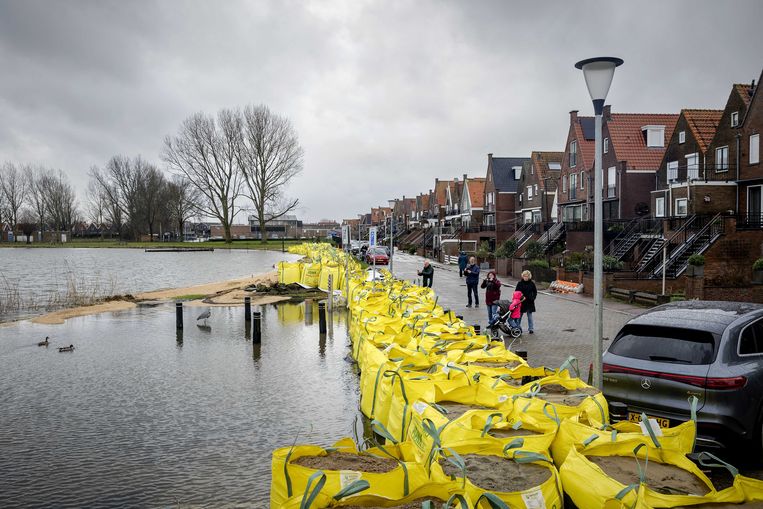It wasn't just us who were drowning or sinking in the last few days. Our neighboring countries, France, the Netherlands and Germany, are also exposed to exceptional rainfall. How do they deal with it there? “We don't know yet how far it can go.”
With the influx of drone images and updates on water levels, you might almost forget, but many other European countries are starting to get their feet wet too. Storm Henk caused significant damage in the United Kingdom. On Wednesday, electricity was cut off for about 10,000 families, and floods occurred here and there. Things are not much better in our neighboring countries. In the regions of Le Nord and Pas-de-Calais, 200 residents were evacuated, and 10,000 French people were without electricity. Out of necessity, France borrowed twelve pumps from the Czech Republic, Slovakia and the Netherlands. However, our northern neighbors cannot escape problems on their own. After the collapse of the dam near Maastricht, the fire brigade had to evacuate many boats.
It is not far to look for an explanation. While we had mild, dry weather in northwestern Europe until mid-October, this has completely changed since then. We have seen a series of low pressure areas since the second half of October. “This means erratic and wet weather,” says meteorologist David Dehenau (KMI). Because of the slow and winding jet stream, as a result of global warming, weather phenomena last longer. Record temperatures have also risen in the North Atlantic this year. Risk of long periods of rainfall Research group World Weather Attribution recently reported that the odds of periods of intense rainfall such as the one we are currently experiencing are 1.2 to 9 times greater due to global warming. “If you see how much damage there is already, we can only conclude that no country is adequately prepared to face global warming,” says hydrologist Patrick Willems (University of KU Leuven).
It is often the same areas that appear most vulnerable to flooding. In the Netherlands, Limburg was one of the worst-hit areas during the floods of summer 2021. The condition of the Meuse River is now also critical, due to all the rainwater the river has to handle from France and the Ardennes region. “From the border with Belgium, the Meuse River passes through a valley where there are relatively few dams and where buildings have been built close to the river,” says researcher Jaap Kwadijk from the Dutch Deltares Knowledge Institute. “The water doesn't have to be very high there to cause problems.”
What is even more extraordinary is the current water level in the IJsselmeer and Markermeer. Residents of Volendam and Hoorn woke up with wet feet at the beginning of this week, and municipalities are now trying to avoid further flooding with extra sandbags. The IJsselmeer receives a lot of water from the overcrowded Rhine. Because the water in the Wadden Sea is very high, the water cannot be drained adequately.
According to Kwadijk, this shows how floods in the Netherlands manifest themselves in a different way. “Unlike, for example, in southern Belgium, we do not have high-speed-flowing rivers. The main problem is that once the water rises, it does not flow easily again. This has now become even more problematic, after the soil has become so saturated that it can barely absorb Water. “Then you can only get rid of the water using pumps,” Kwadijk says.
He stresses that the current situation is exceptional. “The water is now reaching my house in Harlem. I've never experienced that before.” Hydrologist Bruno Merz (GFZ Potsdam) from Germany sees the same thing, where rain fell at twice the usual rate in December. “Then you also see that it's not just the so-called danger zones that are affected. The hotspots are constantly changing depending on the rainfall.
While Bavaria faced problems earlier this month, Lower Saxony, southern Saxony-Anhalt and parts of North Rhine-Westphalia are now mainly affected. Germany is also facing the reality that flooding is becoming an increasing problem. “There have been some investments made in recent years,” says Mears. “We also now see that the additional dams built are more than proving their usefulness. But at the same time we must conclude that this is not enough.”
Providing training to residents
For this reason, according to him, more attention should be paid to how to protect residential care centers or energy facilities in extreme weather situations as is the case now. There should also be training for a wider cross-section of the population on how to protect your home from flooding. “Research shows that people who have thought about this in advance suffer much less harm.”
According to Kwadijk, these conclusions also apply to the Netherlands. “We have long been concerned with water management as engineers. We have built infrastructure based on scenarios that occur once every few hundred years. The situation is changing due to climate change. We do not know yet how extreme this can go.”
He draws hope from the newly established European Research Group, which will conduct joint research and advise the governments of Germany, Belgium, Luxembourg and the Netherlands. “Today, research is still very dependent on each country. We just have to learn from each other how to act quickly and correctly in situations like today.”

“Total coffee specialist. Hardcore reader. Incurable music scholar. Web guru. Freelance troublemaker. Problem solver. Travel trailblazer.”






More Stories
“Ask at least one question in return.”
Elbendamers in the Sun: What a Wonderful Little Village
European Space Agency – Space for Kids